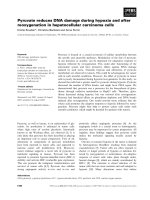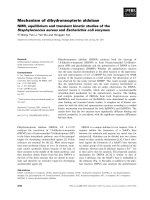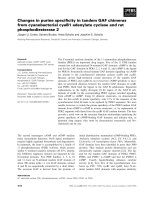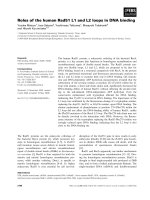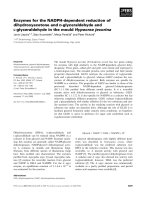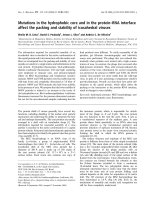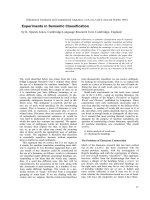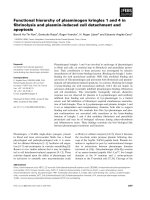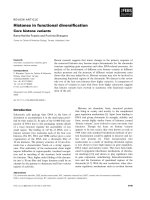Báo cáo khoa học: Enzymes in organic media Forms, functions and applications potx
Bạn đang xem bản rút gọn của tài liệu. Xem và tải ngay bản đầy đủ của tài liệu tại đây (141.58 KB, 9 trang )
REVIEW ARTICLE
Enzymes in organic media
Forms, functions and applications
Munishwar N. Gupta and Ipsita Roy
Chemistry Department, Indian Institute of Technology, Delhi, Hauz Khas, New Delhi, India
Enzyme catalysis in low water containing organic solvents is
finding an increasing number of applications in diverse
areas. This review focuses on some aspects which have not
been reviewed elsewhere. Different strategies for obtaining
higher activity and stability in such media are described. In
this context, the damaging role of lyophilization and the
means of overcoming such effects are discussed. Ultrasoni-
cation and microwave assistance are two emerging approa-
ches for enhancing reaction rates in low water media.
Control of water activity and medium engineering are two
crucial approaches in optimization of catalytic behaviour in
nonaqueous enzymology. Organometallics and synthesis/
modification of polymers are two areas where nonaqueous
enzymology can play a greater role in the coming years. The
greater understanding of enzyme behaviour in nonaqueous
media is expected to lead to larger and even more diverse
kinds of applications.
Keywords: antibodies in organic solvents; enzymes in
organic solvents; high activity enzyme formulations;
medium engineering; microwave assisted enzymatic
reactions; synthesis and modification of polymers.
Introduction
The use of enzymes in organic media (with low water
content) has been one of the most exciting facets of
enzymology in recent times. Its importance can be appre-
ciated from the fact that at least four books [1–4] and
numerous reviews [5–7] are available on the subject. It is an
area in which applications and phenomena preceded the
understanding of catalysis at the molecular level. Also, it
is an area in which enzymologists continue to discover
unexpected and yet fundamental behaviour of biocatalysts.
Thus, the excitement has not yet abated. The present review
aims at two somewhat different objectives. The first one is to
bring together both basic as well as applied aspects. In this
respect, it is an update of the earlier review written by one of
us [5]. The second aim is to cover some aspects which have
not been generally covered by recent reviews. In some cases
(e.g. ultrasonoenzymology and microwave-assisted non-
aqueous enzymology), this is simply because these aspects
are what the media calls Ôbreaking newsÕ. Some important
features of this area which are covered or discussed in detail
elsewhere are: designing enzymes by directed evolution [8,9],
combinatorial biocatalysis [10], synthetic applications inclu-
ding enantiomeric resolution [1,4,6,7,11,12], controlling
enzyme specificity by medium engineering [13], solvent free
systems and eutectic mixtures [1,3,14], smart biocatalysts
in organic media [15], and bioanalysis and biosensors in
organic media [2–5].
Forms and formulations
While free enzyme powders continue to be used in nearly
anhydrous media, a variety of forms and formulations have
been described. There have been two major motivations
behind evolving these designs. The first one has been the
perception that enzymes are not stable in neat organic
solvents. Unfortunately, a clear distinction between expo-
sure to organic media and working in such media has not
been made by many workers. When enzymes are exposed
to such media (stress or denaturing conditions) for a
limited time, and are recovered and checked for biological
activity in water, early studies [16] indicate that full activity
is observed. This implies that no irreversible denaturation
has taken place. On the other hand, enzymes in different
solvents display different k
cat
/K
m
, so operational stability is
different in different organic solvents. A number of solvent
parameters have been described; some have raised the
question of nonpolar solvents not being the same as
hydrophobic solvents [17]. The most acceptable, even if not
totally satisfactory, parameter is log P, where log P is the
partition coefficient of the solvent for the standard octanol/
water two-phase system [18]. Thus, early efforts, and even
some recent ones, have aimed at stabilization of enzymes in
organic media. Chemical modification [19], chemical
crosslinking [20], immobilization [21], protein aggregation
[22,23] and protein engineering [24] have all been tried. Of
these, immobilization has been used most often. In a review
which dispels a lot of vagueness and myths (which are
unfortunately associated with a lot of other papers and
reviews), Halling [25] mentions that the most popular
Correspondence to M. N. Gupta, Department of Chemistry, Indian
Institute of Technology, Delhi, Hauz Khas, New Delhi 110016, India.
Fax: + 91 11 2658 1073, Tel.: + 91 11 2659 1503,
E-mail:
Abbreviation: HRP, horseradish peroxidase.
(Received 28 February 2004, revised 31 March 2004,
accepted 16 April 2004)
Eur. J. Biochem. 271, 2575–2583 (2004) Ó FEBS 2004 doi:10.1111/j.1432-1033.2004.04163.x
immobilization method (adsorption on a support material
like Celite) is, in fact, codrying or deposition rather than
immobilization.
The second kind of design has been prompted by the
appreciation that k
cat
/K
m
in organic media (with low water
content) is far less than the corresponding k
cat
/K
m
in
aqueous media because drying by lyophilization causes
reversible damage to the enzyme structure [26]. Thus, it is
necessary to either prevent this damage or use other
methods of drying. The use of additives (cryoprotectants,
lyoprotectants, salts, etc.) during lyophilization falls in the
former category. The latter approach consists of precipita-
ting enzymes by organic solvents [27]. Some of the forms
and formulations based upon both these approaches are:
lyophilized powders containing cryoprotectants or/and
lyoprotectants [28], propanol rinsed preparations [27],
enzyme precipitated with and rinsed with propanol [29],
enzymes obtained after three-phase partitioning [30], cross-
linked enzyme crystals [22], crosslinked enzyme aggregates
[31] and enzymes coated with ionic liquid [32].
Additives and activation
Lyophilized enzymes are the most common forms of
enzymes used in enzymology. Lyophilization involves
[28,33] (a) initial freezing, (b) primary drying (in which ice
separated from the protein phase is removed by sublimat-
ion) and (c) secondary drying (in which the bound or
trapped water is removed from proteins). Basically, lyo-
philization (or freeze-drying) involves two denaturing
conditions: freezing and drying. Cryoprotectants (very
heterogeneous as far as chemical structures are concerned
(e.g. sugars, amino acids, polyols, salts, etc.) prevent
structural damage due to freeze stress. This protection
may be due to Ôpreferential exclusionÕ [34]. During the drying
stage (dehydration), one needs lyoprotectants. Lyoprotec-
tants substitute water molecules, which are being removed,
by forming H-bonds with the protein structure. Sucrose is a
good example [33]. Evidence (most of it based upon FTIR)
exists, which shows that the absence of lyoprotectant leads
to both the random structure and the a-helical structure
being partially converted to b-sheet structure (in which
peptide bonds are linked to each other via H-bonds). In
conventional enzymology (in aqueous media), rehydration
reverses much of the structural damage during lyophiliza-
tion. In nonaqueous enzymology, this becomes very crucial
and is now considered as largely responsible for the low k
cat
/
K
m
of enzymes in nearly anhydrous media. The k
cat
values
for esterase (in water) and transesterification (in hexane)
activities of subtilisin have been found to be 5.9 · 10
3
and
1.04 · 10
)1
M
)1
Æs
)1
, respectively [26].
Dabulis & Klibanov [35] showed that addition of a
variety of substances (an amino acid derivative, sugars,
polyethylene glycol) during lyophilization resulted in more
active (in the range of 3–321-fold) preparation of seven
hydrolytic enzymes. A few years later, Triantafyllou et al.
[36,37] carried out a more intensive work on the effect of
sorbitol and other additives on a-chymotrypsin and some
lipases. While Dabulis & Klibanov [35] found that higher
activity persists even if excipients are removed, Triantafyllou
et al. [36] found that Ôwashing to remove sorbitol had a
negative effect on the activityÕ of both lipase and
a-chymotrypsin in their immobilized forms. One of the
most remarkable results with additives has been the salt
activation reported by Khmelnitsky et al. [38]. The 3750
times higher activity of subtilisin in the presence of 98%
(w/w) of KCl was tentatively explained by either rigid salt
structure protecting the enzyme in organic solvents or
polar environment of salt helping in maintaining native
structure of the enzyme. Soon after, Bedell et al. [39]
provided evidence that it is not a result of reduced
diffusional limitation. Subsequently, it was shown [40,41]
that salt activation is the result of kosmotropicity and this
stabilizing effect (during lyophilization) operates via prefer-
ential hydration. Also, a combination of kosmotropic salt
sodium acetate and sodium carbonate buffer had a cumu-
lative effect. Hsu & Dordick [42] found that salt activation
enhances enantioselectivity of subtilisin because the
favoured reaction is more sensitive to the structural integrity
of the enzyme. On the other hand, Altreuter et al. [43] found
that salt activation is accompanied by expanded and
unnatural regioselectivity of subtilisin. The latter feature
is very valuable in the use of enzymes for developing
combinatorial biocatalysis [10]. Recently, Lindsay et al. [44]
reported the salt activation of a nonprotease, penicillin
amidase and found that salt activation was dependent upon
the water content in the solvent medium. However, the
preparation lyophilized in the presence of trehalose behaved
differently. The conclusion was that salt activation is
mechanistically distinct from lyoprotection. On the other
hand, Morgan & Clark [45] believe that the Ôpresence of salt
protected enzymes from irreversible activationÕ in several
cases.
To sum up, the picture is still far from clear. That is not
surprising as our appreciation of the role of lyophilization,
while obtaining enzyme preparations for nonaqueous enz-
ymology, is rather recent. That lyophilization, as a pheno-
menon in itself is not simple, is not widely appreciated.
Medium engineering
It was Zaks & Klibanov [46] who reported that the activity
of enzymes was higher in hydrophobic solvents than in
hydrophilic ones. It was Laane & coworkers [18,47] who
first addressed this issue in a comprehensive fashion and
pointed out that log P, as a solvent parameter, correlates
best with enzyme activity. Narayan & Klibanov [17] pointed
out that it is hydrophobicity and not polarity or water
miscibility which is important. As this may lead to some
confusion among biochemists, it is best to quote ‘‘The log P
parameter can be called a measure of solvent Ôhydropho-
bicityÕ, which is an accurate description of what affects its
value. This contrasts with other parameters such as
dielectric, which measure the bulk ÔpolarityÕ. One illustration
of the difference is to consider a homologous series of
solvents. Adding extra methylene groups to an alcohol, for
example, will cause a regular increase in hydrophobicity.
Thus, decanol is more hydrophobic (higher log P) than
hexane, but will be more polar by almost any measure of
bulk properties’’ [25]. It is also pertinent to add that most
often, the medium effects are explained in terms of more
hydrophobic solvents having less tendency to strip water
from enzymes. Such medium effects will not be seen if
identical water activities in both media are used. Many
2576 M. N. Gupta and I. Roy (Eur. J. Biochem. 271) Ó FEBS 2004
solvent effects, in fact, arise from substrate solvation. If a
substrate is more soluble in a solvent, the substrate
molecules will be less available to the enzyme. Thus, higher
K
m
values may lead to lower reaction rates [25]. The nature
of the solvent media affects both the enantio- and regio-
selectivity of the enzymes. Various hypotheses have been
given to rationalize these important effects. No consensus
seems to have emerged so far [7]. Finally, one must
mention Ôsolvent-freeÕ media wherein one or more of the
substrate(s) form the medium and no other solvent is
required. In some cases, this results in more efficient
conversion rates. A good example is the production of
biodiesel with lipases [14]. Biodiesel consists of monoalkyl
esters of long chain fatty acids. There is no petroleum or
other fossil fuel in biodiesel; the diesel part of its name is
based upon the fact that it can be substituted in place of
petroleum diesel fuel. It is produced from vegetable oils or
fats by lipase catalyzed transesterification with methanol or
ethanol [48].
Importance of water activity in nearly
anhydrous media
It is now recognized that less than a monolayer of water is
needed for an enzyme molecule to start showing biological
activity. Beyond this, addition of more water molecules
increases biological activity. However, in the case of
hydrolases, beyond a threshold limit of water concentration,
hydrolytic activity starts effectively competing with trans-
ferase or synthetic activity [49].
The first clue that water content may not be the best
parameter to look at was the work of Zaks & Klibanov [46].
Working with alcohol dehydrogenase in a variety of
solvents, they determined the adsorption isotherm of water
on the enzyme in a variety of solvents. It was observed that
the water present on the enzyme correlated well with the
reaction rates in different solvents. The higher the water
content on the enzyme, the higher was the reaction rate. The
rationale which emerged was that when water is added to
the reaction system, it partitions among the enzyme, solvent,
headspace of the reaction vessel and the immobilization
matrix (if any). Soon after, Halling & coworkers made a
seminal contribution in establishing water activity as a valid
and useful parameter for carrying out biocatalysis in nearly
anhydrous media [25,50–52].
Controlled addition of water continues to be used
because of its simplicity. The relationship between mole
fraction of water and activity in the case of several
organic solvents has been reported [25]. Saturated solu-
tions of different salts are known to release and absorb
water at constant humidity [53]. Wehtje et al. [54] have
described a method by which the water activity can be
kept constant as the reaction proceeds. A saturated
solution of the appropriate salt is pumped through silicon
tubing that passes through the reaction mixture. As the
water molecules can diffuse out of the tubing, the system
remains equilibrated at the same water activity through-
out. Another method, which is becoming increasingly
popular, is the use of a pair of salt hydrates to maintain a
constant water activity level throughout the reaction [49].
Here the lower hydrate or anhydrous form will absorb
water and the higher hydrate will release it. A few years
ago, suitable salt hydrates for different water activity
levels were listed [55].
One area which needs more work is the effect of water
activity on the stereoselectivity of the reaction. There are
already a few reports which show that both rate and
enantiomeric ratio change simultaneously when water
activity is increased [56].
pH tuning and pH memory
This is one dramatic observation [46] for which clear
rationalization is now available [3]. The correct protonation
state of side chains of amino acid residues of enzymes is
important in nonaqueous media as well. Hence pH tuning
(placing the enzyme in water at optimum pH of the enzyme,
and lyophilizing) results in higher rates in organic solvents.
However, this is valid only if the reaction does not change
the acid/base concentration. Such changes have been
mentioned by the same authors [57] who have also described
useful protocols for pH tuning by the use of special buffers.
Microwave-assisted reactions in nonaqueous
enzymology
The microwave region (0.3–300 GHz) falls between the
infrared and radiofrequency regions of the electromagnetic
spectrum. Chemical synthesis using microwave irradiation
has been extensively reported. In this approach, microwave
irradiation replaces conventional forms of heating [58].
Upon irradiation with microwaves, a polar molecule
continually aligns itself with the fluctuating field. This
converts electromagnetic energy into heat energy. It is not
very clear whether these rate enhancements are purely due
to thermal effects or whether some nonthermal effects are
involved [59,60]. For example, Whittaker & Mingos [61]
believe that Ôthe rate of a reaction in many syntheses is so
high that it can not be accounted for by heating effects onlyÕ.
Early work on microwave-assisted enzymatic reactions in
water was naturally limited to the use of thermostable
enzymes [62]. Considering that enzymes are highly thermo-
stable in nearly anhydrous media [2,5,16], it is natural that
microwave assistance is also explored for enzymatic cata-
lysis in such media. Also, the commercial availability of
microwave ovens, which are able to maintain constant
temperature by remote IR feedback control, has also
facilitated work in this area.
Carrillo-Munoz et al. [63] used two commercially
available lipases from Pseudomonas cepacia and Candida
antarctica for esterification and transesterification reactions
at a constant temperature of around 100 °C. The enzymes
were immobilized on matrices which did not absorb
microwaves. The microwave assistance was found to
enhance both initial rates as well as enantioselectivity as
compared to the results obtained under conditions of
classical heating. An interesting result was that the use of
substrates with greater polarity led to greater effect by
microwaves. The results of Parker et al. [64], on the other
hand, emphasized the importance of optimization of water
activity for obtaining maximum increase (two- to threefold)
by microwave assistance. Lin & Lin [65] have also observed
enhanced reaction rates (four- to sixfold) and increase in
stereoselectivity (three- to ninefold) upon use of microwave
Ó FEBS 2004 Enzymes in organic media (Eur. J. Biochem. 271) 2577
irradiations. The molecular mechanisms for these results are
seldom discussed and are not well understood. Chen et al.
[66] have provided a protocol for using microwave assist-
ance for protease catalyzed peptide synthesis. Unfortu-
nately, most of these protocols do not take account of
temperature control during microwave irradiations.
Recently, esterification by a-chymotrypsin and transeste-
rification by subtilisin Carlsberg were accelerated (in the
range of 2.1–4.7 times) in six solvents of differing polarities
and at different water activities [60]. Interestingly, micro-
wave irradiation could be used in conjunction with pH
tuning and salt activation. For example, at the same level of
water activity (0.3%, v/v) in n-octane, untuned subtilisin
showed a transesterification rate of 0.5 mmolÆh
)1
at 25 °C.
The salt-activated and pH tuned subtilisin showed about 20
times increase in reaction rates when microwave irradiations
were used at 25 °C. It was also observed that the choice of
the reaction medium was a factor which dominated the
microwave effect.
Maugard et al. [67] have exploited microwave assistance
for a somewhat different kind of application, i.e. synthesis of
galactooligosaccharides from lactose by using Kluyvero-
myces lactis b-galactosidase. Low water activity, high
lactose concentration and cosolvents with higher log P
value all favoured oligosaccharide synthesis. By optimizing
conditions and using microwave irradiations, the synthesis
of galactooligosaccharides could be increased 217 times. It is
hoped that when more experience with different systems
becomes available, microwave assistance will become a
powerful approach in nonaqueous enzymology.
Ultrasonication
Ultrasound waves have frequencies beyond the normal
range of hearing, which consists of 20 kHz to 100 MHz
and beyond. High power ultrasound waves can generate
cavitation within a liquid. Cavitation provides a source of
energy which can facilitate chemical processes. In this
case, cavitation is an induced bubble activity. Cavitation
can generate very high local pressure (up to 1000 atm)
and very high local temperatures (up to 5000 K) [68,69].
The relevant effects of this are: (a) reduction in particle/
molecule size, (b) generation of free radicals facilitating
mechanisms/pathways which involve free radicals and (c)
increasing the fluid velocity, which facilitates mass transfer
during the reactions. While ultrasonochemistry [70–72] is
now a well-established area, ultrasonoenzymology has
been carried out less extensively [73]. In view of harsh
local environments during ultrasonication, it is expected
that enzymes in nonaqueous media would be able to
withstand ultrasonication better (in view of their higher
stability in such media). Thus, it is not surprising that
attempts have been made to use ultrasonicators in
nonaqueous enzymology. Two distinct types of approa-
ches have been used. Either ultrasonication has been used
as a pretreatment step (for the biocatalyst) or the reaction
has been carried out in the presence of ultrasonic waves.
Both ultrasonic probes and ultrasonic baths have been
used in ultrasonoenzymology. Unfortunately, in many
cases, temperature has not been controlled. In such cases,
one does not know whether the effects on reaction rates
are due to ultrasonication alone or due to the rise in
temperature as well. It is also difficult for others to
reproduce results obtained with such ill-defined condi-
tions. In other cases, temperature has been controlled
either by use of a water-cooled reactor or interrupting
ultrasonication so that the temperature does not rise. In
the latter cases, cycles of ultrasonication and cooling have
been used.
Vulfson et al. [73] carried out subtilisin-catalyzed inter-
esterification and reported (a) that pretreatment of
subtilisin suspensions by ultrasound in alcohols led to
an increase in enzyme activity. This effect was more
pronounced with long-chain alcohols, being 6–8 times
more in octanol as compared to the effect observed in
short chain alcohols. The effect was dependent both on
sonication power and water content of the medium,
(b) the enhancement of reaction rates was, however,
much higher if the reaction was carried out in the
presence of ultrasound. The authors speculated on the
mechanism of these effects; the reduction in mass transfer
constraint because of reduction in enzyme particle size
and increased fluid velocity seemed to be the most
probable factors. Sinisterra [74], in his review on the
application of ultrasound to biotechnology, has men-
tioned data on ultrasonication increasing the percent yield
in protease-catalyzed peptide synthesis in organic solvents.
In hydrocarbons, the more hydrophobic the solvent
(greater log P value), the larger was the sonication effect.
In the case of organic halides, the relative increases under
ultrasonication were CCl
4
>CH
2
Cl
2
>CHCl
3
. The
reviewer concluded that it was difficult to analyze these
facts. Lin & Liu [75] have reported that the use of
ultrasonication enhanced the lipase-catalyzed acylation of
a naphthol derivative with vinyl acetate in benzene-ether
mixture by 83-fold. No temperature control was applied
and hence the enzyme activity decreased if the tempera-
ture crossed 37 °C.
Bracey et al. [76] have re-examined the issue of the
importance of enzyme particle size in nonaqueous envi-
ronments. Zaks & Klibanov [46] had categorically stated
that ÔInternal diffusional limitations were dismissed
because ultrasonication of a suspension of chymotrypsin
in octane (resulting in a reduction of an average enzyme
particle from 270 to 5 lm, as revealed by direct micro-
scopic examination) had no appreciable effect on the
enzymatic transesterification rateÕ. According to Bracey
et al. [76], no enhancement in the reaction rate of
subtilisin-catalyzed interesterification in hexanol by ultra-
sonication could be observed. This was contrary to the
earlier observation of Vulfson et al. [73]. The attempts by
Bracey et al. [76] to reconcile the two contrary results
involve discussions on the possible mechanism(s) of
ultrasonication effects and thus, are worth describing.
Transmission electron microscopy by Bracey et al. [76]
found that ultrasonication changed the open honeycomb
structure of freeze-dried subtilisin into a plate-like struc-
ture. Thus, size reduction did not result in significant
increase in surface area. However, the hydration state of
the enzyme may be critical. According to Rozicwski &
Russell [77], solvation of a subtilisin particle in a
hydrophobic solvent swells it, increasing the diffusion
path for the substrate. If these pores have water
molecules, reactant diffusion is inhibited. In such cases,
2578 M. N. Gupta and I. Roy (Eur. J. Biochem. 271) Ó FEBS 2004
increased fluid velocity by sonication would overcome this
inhibition. Bracey et al. [76] believe that their enzyme was
drier than those of other workers and hence they failed to
observe any increase in reaction rate by ultrasonication. It
is also worth noting that it is the hydration level before
transferring the enzyme to the organic media, which was
found to be critical. Thus, this mechanism does not
explain the correlation between water content of the
medium and the effect of ultrasonication reported earlier
[73]. We need more structural work before ultrasonication
can be used in nonaqueous enzymology in a predictable
manner.
Synthesis and modification of polymers
Dordick et al. [78] have used about 80–85% organic
solvents as media for peroxidase-catalyzed polymerization
of phenols. The use of predominantly nonaqueous media
has two advantages: the substrate phenols can be solubilized
easily, and unlike in water where dimers and trimers
precipitate out of solutions thereby terminating chain
growth, oligomers of 1500–2000 Da range could be
obtained in quite a few cases. Interestingly, it was reported
that Ôthe decline in the molecular weight of the polymers
above 85% dioxane is presently unclearÕ. Margolin et al.
[79] also reported the lipase-catalyzed polycondensation of
reactions between racemic diesters and achiral diols to form
optically active trimers and pentamers.
The peroxidase-catalyzed reaction has been further
exploited for the synthesis of polyaromatic compounds
[80]. Electron paramagnetic resonance studies with spin-
labeled heme in peroxidase have revealed that inactivation
of horseradish peroxidase (HRP) in anhydrous media is
due to the substrate partitioning away from the active site
to the bulk solvent. Whereas aromatic polymers were
formed in both monophasic and biphasic solvents
systems, use of reverse micelles yielded microspheric
particles of uniform size (micrometer range or lower).
The size of the microspheres was dependent upon the
water to surfactant ratio. These nanoparticles could be
used for encapsulating a variety of chemicals and
enzymes. Polyanilines have also been synthesized and
derivatized using HRP in solvent-buffer systems. It has
been pointed out that these polymers have potential
applications in biosensors, optical and electroptical
devices and chromatography [80].
Cellulase has been used in aqueous-cosolvent systems to
synthesize crystalline cellulose [81]. Lipases and proteases
have been used for the synthesis of polyesters in supercritical
fluids [82,83].
Immobilized lipase has been used to catalyze ring-
opening/polymerization of 12-dodecanolide and e-capro-
lactone [84,85]. Enzyme-catalyzed polytransesterification of
alkanedioates and butane-1,4-diol in organic solvents has
also been successfully carried out [86].
Use of subtilisin (solubilized by formation of protein-
surfactant ion-pair method) in iso-octane for transesterifica-
tion of a thin layer of amylose (deposited onto zinc-selenide
plates) has been described [80]. The modification was
followed by FTIR and thermogravimetric analysis of
amylose.
1
H-NMR showed that all available primary amino
groups were acylated. Further work in this area will
definitely be useful in obtaining novel carbohydrate mate-
rials for a variety of applications.
Enzyme modification by directed evolution
This approach originated in the realization that an enzyme
is designed or evolved for a particular function and works
in vivo as a part of a complex metabolic network. In many
situations, these two features are constraints for indus-
trial biocatalysts, especially if they are to be used in
unnatural environments such as organic media. The
approach consists of:
Random mutations [87–89]
At the outset, it is clear that one has to limit the number of
mutations to only one or two residues at a time, otherwise
the number of sequences generated will be unmanageably
large. In the next step, it is possible to recombine and
accumulate such beneficial mutations. This approach has
been successfully used by Moore & Arnold [88] for directing
the evolution of an esterase with desirable specificity. The
choice of a suitable screening procedure also requires careful
consideration. The screening procedure has to be simple so
that a high throughput screening device such as an ELISA
reader can be used. In reality, one desires a combination
of new or retained features in the evolved enzyme: high
expression levels, suitable pH or temperature optima,
enantioselectivity and of course, high activity towards a
particular substrate. While Ôdirecting evolutionÕ one has to
make sure that one does not evolve one desirable property
at the expense of other(s). A screening method can normally
evaluate only one or at the most, a few, features.
The overall strategy is then to carry out many generations
of random mutagenesis by introducing errors while per-
forming PCR. At each generation, the candidate having the
best feature (which is being screened) is subjected to the next
generation. The final enzyme, the result of this evolutionary
progress, will be a more suitable biocatalyst for predecided
function and milieu.
In vitro
combination
In this alternate way of accumulating desirable changes
(and features), the useful mutations identified during a
generation can be recombined by ÔDNA shufflingÕ or
Ôsexual PCRÕ [90,91]. ÔWhen combined with screening,
DNA shuffling allows the discovery of the best combi-
nations of mutations and does not assume that the best
combination contains all the mutations in a populationÕ
[92]. This form of recombination can simultaneously
remove mutations associated with wrong features which
may not have been screened out.
Arnold & her coworkers have combined the two
approaches (of random mutagenesis and in vitro recombi-
nation) to obtain an esterase for hydrolyzing p-nitrobenzyl
ester in the presence of polar organic solvents [88,93]. The
application was to selectively remove p-nitrobenzyl groups
during the synthesis of cephalosporin type antibiotics. The
starting enzyme was from Bacillus subtilis with low p-nitro-
benzyl esterase activity, especially in the polar organic
solvents required to solubilize the esters. The clone obtained
Ó FEBS 2004 Enzymes in organic media (Eur. J. Biochem. 271) 2579
by directed evolution showed more than 150-fold greater
total activity than the wild type clone. It was also more
stable in 15% (v/v) dimethyl formamide.
Unlike site-directed mutagenesis, directed evolution can
be applied without much structural and mechanistic infor-
mation about an enzyme.
Using antibodies in organic solvents
Using antibodies in organic media provides a good oppor-
tunity to carry out immunoassays of water insoluble
antigens [94]. One major application of this is in environ-
mental control and analysis [95]. Russell et al. [96] showed
that antigen–antibody interaction is possible in low water
containing organic solvents. Stocklein et al. [97] studied
binding of triazine herbicides to antibodies in nearly
anhydrous media. The work of Matsuura et al. [98] on
screening monoclonals for okadaic acid in the context of
shellfish poisoning is worth mentioning. Okahata &
Yamaguchi [99] described a lipid-coated catalytic antibody
which was soluble in organic cosolvents and had higher k
cat
as compared to the native molecule in such media. Recently,
catalytic antibody, 38C2 with aldolase activity, has become
commercially available. It has been found that 38C2 can
catalyze a retroaldolization reaction in both aqueous and
organic solvents [100].
Hydrolysis and esterification of
organometallic substrates
Suitable substrates for this type of reaction include
orgnosilicon and organotin compounds and P-bonded
complexes of iron, chromium and manganese [7,101]. A
critical feature is allowing stereoselective reactions of
water sensitive compounds to be carried out. Kinetic
resolution of a-hydroxystannanes by lipases is described
[102]. a-Hydroxystannanes are valuable synthetic reagents,
notable as precursors to a-alkoxy lithium species, which
react with a number of electrophiles, with retention of
configuration at the a-center. Several applications include
simple quenching with CO
2
to access a-hydroxy acid [103]
and double bond transmetallation to generate a function-
alized organocopper reagent for use in conjugate addition
reactions [104]. The first use of an enzyme for the
resolution of organotin compounds was reported by Itoh
& Ohta [105] who examined the enatioselective hydrolysis
of racemic a-acyloxystannanes catalyzed by Pseudomonas
sp. lipases.
Conclusion
Finally, one can conclude by mentioning that few trends in
nonaqueous enzymology can be clearly seen. The first trend
is that although lipases and proteases continue to dominate
vis-a
`
-vis applications in the nonaqueous media, other
enzymes like oxidoreductases (alcohol dehydrogenase,
catalase, peroxidase) [3], penicillin amidase [106], b-glucosi-
dase [2], b-galactosidase [68], catalytic antibodies [2] and
whole cells [2] are also beginning to be used in organic
media. Given the large number of lipases and proteases
available with a wide range of specificities, this picture is
unlikely to change significantly. The second trend is that
greater understanding (at the molecular level) of the way
enzymes behave in such media is emerging. The focus right
now is on creating formulations/designs with greater
activity. The control of water activity during the reaction
is crucial. Microwave assistance and ultrasonoenzymology
in such media have not yet been extensively studied,
therefore one is likely to see more work in this area in the
coming years. The iterative process of application fi basic
understanding fi more applications is likely to continue
for a while in this area.
Acknowledgements
The financial assistance from Department of Science and Technology,
Department of Biotechnology, Council for Scientific and Industrial
Research (both Extramural Division and Technology Mission on
Oilseeds, Pulses and Maize) and National Agricultural Technology
Project (Indian Council for Agricultural Research), all of which are
Government of India organizations, is gratefully acknowledged.
References
1. Koskinen, A.M.P. & Klibanov, A.M. (1996) Enzymatic Reac-
tions in Organic Media. Blackie, London.
2. Gupta, M.N. (2000) Methods in Nonaqueous Enzymology.
Birkhauser-Verlag, Basel.
3. Vulfson, E.N., Halling, P.J. & Holland, H.L. (2001) Enzymes in
Nonaqueous Solvents, Methods and Protocols. Humana Press,
New Jersey.
4. Drauz, K. & Waldmann, H. (2002) Enzyme Catalysis in Organic
Synthesis, Vol. I Wiley-VCH, Weinheim.
5. Gupta, M.N. (1992) Enzyme function in organic solvents. Eur. J.
Biochem. 20 3, 25–32.
6. Khmelnitsky, Y.L. & Rich, J.O. (1999) Biocatalysis in nonaqu-
eous solvents. Curr. Opin. Chem. Biol. 3, 47–53.
7. Carrea, G. & Riva, S. (2000) Properties and synthetic applica-
tions of enzymes in organic solvents. Angew. Chemie Int. 39,
2226–2254.
8. Bornscheuer, U.T. & Pohl, C. (2001) Improved biocatalysts by
directed evolution and rational protein design. Curr. Opin. Chem.
Biol. 5, 137–143.
9. Brakmann, S. & Johnsson, K. (2002) Directed Molecular Evolu-
tion of Proteins. Wiley-VCH, Weinheim.
10. Rich, J.O., Michels, P.C. & Khmelnitsky, Y.L. (2002) Combi-
natorial biocatalysis. Curr. Opin. Chem. Biol. 6, 161–167.
11. Bornscheuer, U.T. (2002) Microbial carboxyl esterases: classifi-
cation, properties and application in biocatalysis. FEMS
Microbiol. Rev. 26 , 73–81.
12. Powers, R. (1999) Biocatalysts for Chemical Synthesis. John
Wiley & Sons, Chichester.
13. Wescott, C.R. & Klibanov, A.M. (1994) The solvent dependence
of enzyme specificity. Biochim. Biophys. Acta 1206,1–9.
14. Xu,Y.Du,W.,Liu,D.&Zeng,J.(2003)Anovelenzymatic
route for biodiesel production from renewable oils in a solvent-
free medium. Biotechnol. Lett. 25 , 1239–1241.
15. Roy, I. & Gupta, M.N. (2003) Smart polymeric materials:
Emerging biochemical applications. Chem. Biol. 10, 1161–
1171.
16. Klibanov, A.M. (1989) Enzymatic catalysis in anhydrous organic
solvents. Trends Biochem. Sci. 14, 141–144.
17. Narayan, V.S. & Klibanov, A.M. (1993) Are water-immiscibility
and apolarity of the solvent relevant to enzyme efficiency?
Biotechnol. Bioeng. 41, 390–393.
18. Laane, C. (1987) Medium engineering for bioorganic synthesis.
Biocatalysis 30, 80–87.
2580 M. N. Gupta and I. Roy (Eur. J. Biochem. 271) Ó FEBS 2004
19. Jiang, Y. & Dalton, H. (1994) Chemical modification of the
hydroxylase of soluble methane monooxygenase gives one form
of the protein with significantly increased thermostability and
another that functions well in organic solvents. Biochim. Biophys.
Acta 1201, 76–84.
20. DeSantis, G. & Jones, J.B. (1999) Chemical modification of
enzymes for enhanced functionality. Curr. Opin. Biotechnol. 10 ,
324–330.
21. Persson, M., Wehtje, E. & Adlercreutz, P. (2002) Factors gov-
erning the activity of lyophilised and immobilised lipase pre-
parations in organic solvents. Chembiochem. 3, 566–571.
22. Govardhan, C.P. (1999) Crosslinking of enzymes for improved
stability and performance. Curr. Opin. Biotechnol. 10, 331–335.
23. Tyagi, R., Batra, R. & Gupta, M.N. (1999) Amorphous enzyme
aggregates: Stability towards heat and aqueous-organic cosolvent
mixtures. Enzyme Microb. Technol. 24, 348–354.
24. Cirino, P.C. & Arnold, F.H. (2002) Protein engineering of oxy-
genases for biocatalysis. Curr. Opin. Chem. Biol. 6, 130–135.
25. Halling, P.J. (2002) Enzymic conversions in organic and other
low-water media. In Enzyme Catalysis in Organic Synthesis.
(Drauz, K. & Waldmann, H., eds), Vol. I, pp. 259–285. Wiley-
VCH, Weinheim.
26. Lee, M Y. & Dordick, J. S. (2002) Enzyme activation for non-
aqueous media. Curr. Opin. Biotechnol. 13 , 376–384.
27. Partridge, J., Halling, P.J. & Moore, B.D. (1998) Practical route
to high activity enzyme preparations for synthesis in organic
media. Chem. Commun. 7, 841–842.
28. Roy, I. & Gupta, M.N. (2004) Freeze-drying of proteins: Some
emerging concerns. Biotechnol. Appl. Biochem. 39, 165–177.
29. Roy, I. & Gupta, M.N. (2004) Preparation of highly active
a-chymotrypsin for catalysis in organic media. Bioorg. Med.
Chem. Lett. 14, 2191–2193.
30. Roy, I. & Gupta, M.N. (2004) Enhancing reaction rate for
transesterification reaction catalyzed by Chromobacterium lipase.
Enzyme Microb. Technol. in press.
31. Cao, L., Langen, L. & Sheldon, R.A. (2003) Immobilised
enzymes: carrier-bound or carrier-free? Curr. Opin. Biotechnol.
14, 387–394.
32. Lee, J.K. & Kim, M J. (2002) Ionic liquid-coated enzyme for
biocatalysis in organic solvents. J. Org. Chem. 67, 6845–6847.
33. Arakawa, T., Prestelski, S.J., Kenney, W.C. & Carpenter, J.F.
(2001) Practical route to high activity enzyme preparations for
synthesis in organic media. Adv.DrugDeliv.Rev.46, 307–326.
34. Timasheff, S.N. (2002) Protein–solvent preferential interactions,
protein hydration, and the modulation of biochemical reactions
by solvent components. Proc. Natl Acad. Sci. USA 99, 9721–
9726.
35. Dabulis, K. & Klibanov, A.M. (1993) Dramatic enhancement of
enzymatic activity in organic solvents by lyoprotectants. Bio-
technol. Bioeng. 41, 566–571.
36. Triantafyllou, A.O., Wehtje, E., Adlercreutz, P. & Mattiasson, B.
(1995) Effects of sorbitol addition on the action of free and
immobilized hydrolytic enzymes in organic media. Biotechnol.
Bioeng. 45 , 406–414.
37. Triantafyllou, A.O., Wehtje, E., Adlercreutz, P. & Mattiasson, B.
(1997) How do additives affect enzyme activity and stability in
nonaqueous media? Biotechnol. Bioeng. 54 , 67–76.
38. Khmelnitsky,Y.L.,Welch,S.H.,Clark,D.S.&Dordick,J.S.
(1994) Salts dramatically enhance activity of enzymes suspended
in organic solvents. J. Am. Chem. Soc. 116, 2647–2648.
39. Bedell, B.A., Mozhaev, V.V., Clark, D.S. & Dordick, J.S. (1998)
Testing for diffusion limitations in salt-activated enzyme cata-
lysts operating in organic solvents. Biotechnol. Bioeng. 58,
654–657.
40. Ru,M.T.,Hirokane,S.Y.,Lo,A.S.,Dordick,J.S.,Reimer,J.A.
& Clark, D.S. (2000) On the salt-induced activation of lyophilized
enzymes in organic solvents: Effect of salt kosmotropicity on
enzyme activity. J. Am. Chem. Soc. 122, 1565–1571.
41.Ru,M.T.,Reimer,J.A.,Dordick,J.S.&Clark,D.S.(2001)
Towards more active biocatalysts in organic media: increasing
the activity of salt-activated enzymes. Biotechnol. Bioeng. 75,
187–196.
42. Hsu, W.T. & Dordick, J.S. (2001) Variations in the enantios-
electivity of salt-activated subtilisin induced by lyophilization.
Biotechnol. Bioeng. 73, 231–237.
43. Altreuter, D.H., Dordick, J.S. & Clark, D.S. (2002) Nonaqueous
biocatalytic synthesis of new cytotoxic doxorubicin derivatives:
exploiting unexpected differences in the regioselectivity of salt-
activated and solubilized subtilisin. J. Am. Chem. Soc. 124 , 1871–
1876.
44. Lindsay, J.P., Clark, D.S. & Dordick, J.S. (2004) Combinatorial
formulation of biocatalyst preparations for increased activity in
organic solvents: Salt activation of penicillin amidase. Biotechnol.
Bioeng. 85 , 553–560.
45. Morgan, J.A. & Clark, D.S. (2004) Salt-activation of non-
hydrolase enzymes for use in organic solvents. Biotechnol. Bioeng.
85, 456–459.
46. Zaks, A. & Klibanov, A.M. (1988) Enzyme catalysis in non-
aqueous solvents. J. Biol. Chem. 263, 3194–3201.
47. Laane, C., Boeren, S., Vos, K. & Veeger, C. (1987) Rules for
optimization of biocatalysis in organic-solvents. Biotechnol.
Bioeng. 30 , 81–87.
48. Shah, S., Sharma, S. & Gupta, M.N. (2003) Enzymatic transes-
terification for biodiesel production. Ind. J. Biochem. Biophys. 40,
392–399.
49. Anthonsen, T. & Sjurnes, B.J. (2000) Importance of water
activity for enzyme catalysis in nonaqueous organic systems. In
Methods in Nonaqueous Enzymology (Gupta, M.N., ed.), pp. 14–
35. Birkhauser-Verlag, Basel.
50. Valivety, R.H., Halling, P.G., Peilow, A.D. & Macrae, A.R.
(1994) Relationship between water activity and catalytic activity
of lipases in organic media. Effects of supports, loading and
enzyme preparation. Eur J. Biochem. 222, 461–466.
51. Halling, P.J. (1994) Thermodynamic predictions for biocatalysis
in nonconventional media: theory, tests, and recommendations
for experimental design and analysis. Enzyme Microb. Technol.
16, 178–206.
52. Erbeldinger, M., Ni, X. & Halling, P.J. (1998) Effect of water and
enzyme concentration on thermolysin-catalyzed solid-to-solid
peptide synthesis. Biotechnol. Bioeng. 59, 68–72.
53. Greenspan, L. (1977) Humidity fixed points of binary saturated
aqueous solutions. J. Res. Nat. Bur. Std. (U.S.) 81A, 89–96.
54. Wehtje, E., Svensson, I., Adlercreutz, P. & Mattiasson, B. (1994)
Continuous control of water activity during biocatalysis in
organic media. Biotechnol. Tech. 7, 873–878.
55. Zacharis,E.,Omar,I.,Partridge,J.,Robb,D.&Halling,P.
(1997) Selection of salt hydrate pairs for use in water control in
enzyme catalysis in organic solvents. Biotechnol. Bioeng. 55,367–
374.
56. Santaniello, E., Ferraboschi, P. & Grisenti, P. (1990) An efficient
chemo-enzymatic approach to the enantioselective synthesis of
2-methyl-1,3-propanediol derivatives. Tetrahedron Lett. 31,
5657–5660.
57. Partridge, J., Harper, N., Moore, B.D. & Halling, P.J. (2001)
Enzymes in Nonaqueous Solvents: Methods and Protocols (Vulf-
son, E.N., Halling, P.J. & Holland, H.L., eds), pp. 227–234.
Humana Press, New Jersey.
58. Varma, R.S. (2002) Advances in Green Chemistry: Chemical
Synthesis Using Microwave Irradiation. Astra Zeneca Research
Foundation India, Bangalore.
59. Adam, D. (2003) Microwave chemistry: Out of the kitchen.
Nature 421, 571–572.
Ó FEBS 2004 Enzymes in organic media (Eur. J. Biochem. 271) 2581
60. Roy, I. & Gupta, M.N. (2003) Non-thermal effects of micro-
waves on protease-catalyzed esterification and transesterification.
Tetrahedron 59, 5431–5436.
61. Whittaker, A.G. & Mingos, D.M.P. (1995) Microwave-assisted
solid-state reactions involving metal powders. J. Chem. Soc.
Dalton Trans. 20, 2073–2079.
62. Porcelli, M., Cacciapuoti, G., Fusco, S., Massa, R., d’Ambrosio,
G., Bertoldo, C., De Rosa, M. & Zappia, V. (1997) Non-thermal
effects of microwaves on proteins: thermophilic enzymes as
model system. FEBS Lett. 402, 102–106.
63. Carrillo-Munoz, J R., Bouvet, D., Guibe-Jampel, E., Loupy, A.
& Petit, A. (1996) Microwave-promoted lipase-catalyzed reac-
tions. Resolution of (±)-1-phenylethanol. J. Org. Chem. 61,
7746–7749.
64. Parker,M C.,Besson,T.Lamare,S.&Legoy,M D.(1996)
Microwave radiation can increase the rate of enzyme-catalysed
reactions in organic media. Tetrahedron Lett. 37 , 8383–8386.
65. Lin, G. & Lin, W Y. (1998) Microwave-promoted lipase-
catalyzed reactions. Tetrahedron Lett. 39, 4333–4336.
66. Chen, S T., Sookkheo, B., Phutrahul, S. & Wang, K.T. (2001)
Enzymes in nonaqueous solvents: Applications in carbohydrate
and peptide preparation. In Enzymes in Nonqueous Solvents:
Methods and Protocols (Vulfson, E.N., Halling, P.J. & Holland,
H.L., eds), pp. 373–400. Humana Press, New Jersey.
67. Maugard,T.,Gaunt,D.,Legoy,M.D.&Besson,T.(2003)
Microwave-assisted synthesis of galacto-oligosaccharides from
lactose with immobilized beta-galactosidase from Kluyveromyces
lactis. Biotechnol. Lett. 25, 623–629.
68. Apfel, R.E. (1997) Sonic effervescence: a tutorial on acoustic
cavitation. J. Acoust. Soc. Am. 101, 1227–1237.
69. Mason, T.J. (1997) Ultrasound in synthetic organic chemistry.
Chem.Soc.Rev.26, 443–451.
70. Luche, J.L., Einhorn, C. & Einhorn, J. (1990) Organic
sonochemistry: a new interpretation and its consequences. Tet-
rahedron Lett. 31, 4125–4128.
71. Margulis, M.A. (1992) Fundamental aspects of sonochemistry.
Ultrasonics 30 , 152–154.
72. Miethchen, R. (1992) Selected applications of sonochemistry in
organic chemistry. Ultrasonics 30, 173–179.
73. Vulfson, E.N., Sarney, D.B. & Law, B.A. (1991) Enhancement of
subtilisin-catalyzed interesterification in organic solvents by
ultrasound irradiation. Enzyme Microb. Technol. 13 , 123–126.
74. Sinisterra, J.V. (1992) Applications of ultrasound to biotechno-
logy: An overview. Ultrasonics 30, 180–185.
75. Lin, G. & Liu, H.C. (1995) Ultrasound-promoted lipase cata-
lyzed reactions. Tetrahedron Lett. 36, 6067–6068.
76. Bracey, E., Stenning, R.A. & Brooker, B.E. (1998) Relating the
microstructure of enzyme dispersions in organic solvents to their
kinetic behaviour. Enzyme Microb. Technol. 22 , 147–191.
77. Rozicwski, K. & Russel, A.J. (1992) Effect of hydration on the
morphology of enzyme powder. Biotechnol. Bioeng. 39, 1171–
1175.
78. Dordick, J.S., Marletta, M.A. & Klibanov, A.M. (1987) Poly-
merization of phenols catalyzed by peroxidase in nonaqueous
media. Biotechnol. Bioeng. 30, 31–36.
79. Margolin, A.L., Crenne, J.Y. & Klibanov, A. (1987) M Stereo-
selective oligomerization catalyzed by lipases in organic solvents.
Tetrahedron Lett. 28 , 1607–1610.
80. Akkara, J.A., Ayyagiri, M.S.R. & Bruno, F.F. (1999) Enzymatic
synthesis and modification of polymers in nonaqueous solvents.
Trends Biotechnol. 17 , 67–73.
81. Kobayashi, S. & Shoda, S. (1995) Chemical synthesis of cellulose
and cello-oligomers using a hydrolysis enzyme as a catalyst. Int.
J. Biol. Macromol. 17, 373–379.
82. Kamat, S.V., Iwaskewycz, B., Beckman, E.J. & Russell, A.J.
(1993) Biocatalytic synthesis of acrylates in supercritical fluids:
Tuning enzyme activity by changing pressure. Proc. Natl Acad.
Sci. USA 90, 2940–2944.
83. Kamat, S.V., Beckman, E.J. & Russel, A.J. (1993) Control of
enzyme enantioselectivity with pressure changes in supercritical
fluoroform. J. Am. Chem. Soc. 115 , 8845–8846.
84. Suzuki,Y.,Taguchi,S.,Hisano,T.,Toshima,K.,Matsumura,S.
& Doi, Y. (2003) Correlation between structure of the lactones
and substrate specificity in enzyme-catalyzed polymerization for
the synthesis of polyesters. Biomacromolecules 4, 537–543.
85. Deng, F. & Gross, R.A. (1999) Ring-opening bulk poly-
merization of epsilon-caprolactone and trimethylene carbonate
catalyzed by lipase Novozym 435. Int. J. Biol. Macromol. 25,
153–159.
86. Kline, B.J., Lele, S.S., Lennart, P.J., Beckman, E.J. & Russell,
A.J. (2000) Use of a batch-stirred reactor to rationally tailor
biocatalytic polytransesterification. Biotechnol. Bioeng. 67 , 424–
434.
87. Shao, Z. & Arnold, F.H. (1996) Engineering new functions and
altering existing functions. Curr.Opin.Struct.Biol.6, 513–518.
88. Moore, J.C. & Arnold, F.H. (1996) Directed evolution of a para-
nitrobenzyl esterase for aqueous-organic solvents. Nat. Bio-
technol. 14, 458–467.
89. Castro, G.R. & Knubovets, T. (2003) Homogeneous biocatalysis
in organic solvents and water-organic mixtures. Crit.Rev.Bio-
technol. 23, 195–231.
90. Stemmer, W.P. (1994) Rapid evolution of a protein in vitro by
DNA shuffling. Nature 370 , 389–391.
91. Crameri, A., Dawes, G., Rodriguez, E. Jr, Silver, S. & Stemmer,
W.P. (1997) Molecular evolution of an arsenate detoxification
pathwaybyDNAshuffling.Nat. Biotechnol. 15 , 436–438.
92. Moore, G.L. & Maranas, C.D. (2000) Modeling DNA mutation
and recombination for directed evolution experiments. J. Theor.
Biol. 205, 483–503.
93. Arnold, F.H. & Moore, J.C. (1997) Optimizing industrial en-
zymes by directed evolution. Adv.Biochem.Eng.Biotechnol.58,
1–14.
94. Gupta, M.N. (2002) Non-aqueous enzymology: Issues and per-
spectives. In Methods in Nonaqueous Enzymology (Gupta, M.N.,
ed.), pp. 1–13. Birkhauser-Verlag, Basel.
95. Sherry, J.P. (1992) Environmental chemistry: The immunoassay
option. Crit. Rev. Anal. Chem. 23, 217–300.
96. Russel,A.J.,Trudel,L.J.,Skipper,P.L.,Groopman,J.D.,Tan-
nenbaum, S.R. & Klibanov, A.M. (1989) Antibody-antigen
binding in organic solvents. Biochem. Biophys. Res. Commun.
158, 80–85.
97. Stocklein, W., Gebbert, A. & Schmid, R.D. (1990) Binding of
triazine herbicides to antibodies in anhydrous organic solvents.
Anal. Lett. 23, 1465–1476.
98. Matsuura, S., Hamano, Y., Kita, H. & Takagaki, Y. (1993)
Preparation of mouse monolclonal antibodies to okadaic acid
and their binding activity in organic solvents. J. Biochem. 114,
273–278.
99. Okahata, Y. & Yamaguchi, M. (1995) A lipid-coated catalytic
antibody in water miscible organic solvents. Tetrahedron 51,
7673–7680.
100. Hoffmann, T., Zhong, G., List, B., Shabat, D., Anderson, J.,
Gramatikova, S., Lerner, R.A. & Barbas, C.F. III (1998) Aldo-
lase antibodies of remarkable scope. J. Am. Chem. Soc. 120,
2768–2779.
101. Santaniello,E.,Ferraboschi,P.,Grisenti,P.&Manzocchi,A.
(1992) The biocatalytic approach to the preparation of
enantiomerically pure chiral building blocks. Chem. Rev. 92,
1071–1140.
102. Chong, J.M. & Mar., E.K. (1991) Preparation of enantio-
merically enriched a-hydroxystannanes via enzymatic resolution.
Tetrahedron Lett. 32 , 5683–5686.
2582 M. N. Gupta and I. Roy (Eur. J. Biochem. 271) Ó FEBS 2004
103. Chan, P.C.M. & Chong, J.M. (1985–88) (1990) Preparation
of enantiomerically enriched a-hydroxy acid derivatives from
a-alkoxyorganostannanes. Tetrahedron Lett. 31 .
104. Linderman, R.J. & Griedel, B. (1991) Configurationally fixed
alpha-alkoxyorganocopper reagents: 1,4-addition of cyclic
enantiopure transferable ligands with complete retention of
configuration. J. Org. Chem. 56, 5491–5493.
105. Itoh, T. & Otah, T. (1990) A simple method for the preparation
of optically active a-hydroxystannanes by the enantioselective
hydrolysis using a lipase. Tetrahedron Lett. 31, 6407–6408.
106. Lindsay, J.P., Clark, D.S. & Dordick, J.S. (2002) Penicillin
amidase is activated for use in nonaqueous media by lyophilizing
in the presence of potassium chloride. Enzyme Microb. Technol.
31, 193–197.
Ó FEBS 2004 Enzymes in organic media (Eur. J. Biochem. 271) 2583
